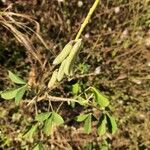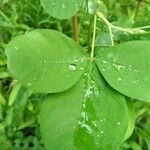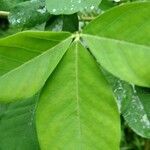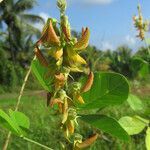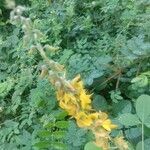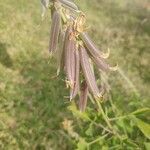Erect well-branched herb, up to 1-2(-3) m tall; branches ± densely covered with short appressed hairs. Leaves 3(-4)-foliolate; leaflets elliptic to obovate, mostly 3-13 x 2.5-7 cm, appressed puberulous beneath; petioles ± as long as the leaflets or shorter. Stipules filiform, up to 3 mm long, caducous, or lacking. Racemes shortly pedunculate, up to 15-30 cm long, with many flowers rather closely arranged at least towards the top; bracts linear, up to 5 mm long, caducous before the flowers open; bracteoles at base of calyx similar but a little smaller. Calyx becoming basally truncate and deflexed against the pedicel, 6-7.5 mm long, ± densely appressed pubescent; lobes narrowly triangular-acuminate, sub-equal to or longer than the tube. Standard elliptic, yellow, usually veined reddish brown; wings much shorter than the keel; keel rather shallowly rounded with a narrow somewhat projecting beak, 12-14(-15) mm long, yellowish green, usually conspicuously veined brown or purple. Legume shortly stipitate, subcylindrical, sometimes slightly curved, 3.8-5 x 0.6-0.8 cm, puberulous, usually glabrescent, ±30-40-seeded. Seeds oblique-cordiform, ±3.5 mm long, smooth or minutely papillose, mottled ochre and dark grey-green, or brown.
Herbs, perennial. Branches terete, ribbed, densely appressed pubescent. Stipules acicular, very minute, caducous. Leaves 3-foliolate; petiole 2-4 cm; petiolules 1-2 mm; leaflet blades oblong to elliptic, 3-6 × 1.5-3 cm, abaxially sparsely silky pubescent, adaxially glabrous, veins distinct on both surfaces, base broadly cuneate, apex obtuse to retuse. Racemes terminal, ca. 25 cm, 10-40-flowered; bracts linear, ca. 4 mm, caducous. Pedicel 3-5 mm; bracteoles inserted at base of calyx tube, similar to bracts, ca. 2 mm. Calyx subcampanulate, 4-6 mm, 5-lobed, densely pubescent; lobes triangular, ± as long as tube. Corolla yellow, exserted beyond calyx; standard orbicular to elliptic, ca. 1 cm in diam., base with 2 appendages; wings oblong, ca. 8 mm, marginally pilose on basal part; keel ca. 1.2 cm, rather shallowly rounded, marginally pilose at base, beak narrow and ± projecting. Ovary subsessile. Legume oblong, 3-4 × 0.5-0.8 cm, 20-30-seeded, pilose when young but glabrescent. Fl. Sep-Oct, fr. Nov-Dec.
An annual herb. It grows 1-2 m tall and spreads 0.5-1 m wide. The branches are erect and have silky hairs when young. The leaves have 3 leaflets. The leaf stalks are 3-9 cm long. The leaflets are 5-8 cm long by 2-4 cm wide. They are oblong and grey-green. They have silky hairs underneath. The flowers occur in clusters that are 15-20 cm long. These are at the ends of branches. The flowers are 1-1.5 cm long and golden yellow. They have prominent lines along them. The fruit are pods 2.5-3.5 cm long and narrow.
Standard elliptic, yellow, usually veined reddish-brown, glabrous outside; wings much shorter than the keel; keel 1.2–1.4(1.5) cm long, shallowly rounded, with a narrow somewhat projecting pointed beak (slightly incurved only at the tip), yellowish-green, sometimes conspicuously lined brown or purple.
Leaves 3(4)-foliolate; leaflets mostly 3–13 × 2.5–7 cm, elliptic to obovate, appressed puberulous beneath; petiole ± as long as leaflets or shorter; stipules up to 3 mm long, filiform, deciduous, or absent.
Racemes shortly pedunculate, mostly 15–30 cm long, many-flowered; bracts up to 5 mm long, linear, caducous before the flowers open; bracteoles at the base of the calyx, similar but smaller.
Calyx 6–7.5 mm long, becoming basally truncate and deflexed against the pedicel, ± densely appressed pubescent; lobes narrowly triangular-acuminate, subequal to or longer than the tube.
Pod 3.8–5 × 0.6–0.8 cm, shortly stipitate, subcylindrical, sometimes slightly curved, puberulous, usually glabrescent, 30–40-seeded.
Seeds c. 3.5 mm long, oblique-cordiform, smooth to minutely papillose, brown or mottled ochre and dark grey-green.
Erect well-branched sometimes robust herb 1–2(3) m tall; branches densely appressed pubescent.
